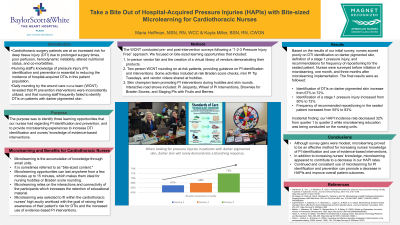Evidence-Based Practice
(EBP-008) Take a Bite out of Hospital-acquired Pressure Injuries with Bite-sized Microlearning for Cardiothoracic Nurses
Friday, May 2, 2025
7:45 PM - 8:45 PM East Coast USA Time

Kayla Miller, BSN, RN, CWON – Wound Ostomy Nurse Specialist, Wound Care / Education, Baylor Scott & White Health
Introduction: Cardiothoracic acute care patients are at an increased risk for deep tissue injury (DTI) development due to prolonged surgery times, poor perfusion, hemodynamic instability, altered nutritional status, and co-morbidities. The nursing staff’s knowledge of pressure injury (PI) identification and prevention is essential to reducing the incidence of hospital-acquired DTIs in this patient population.
Daily rounding by the wound care nurse team (WCNT) revealed that PI prevention interventions were inconsistently utilized, and that the nursing staff frequently failed to identify DTIs on patients with darker pigmented skin.
The purpose was to identify three learning opportunities that our cardiothoracic nurses had regarding PI identification and prevention and to provide micro-learning experiences to increase DTI identification and nurses’ knowledge of evidence-based interventions.
Methods: The WCNT conducted pre- and post-intervention surveys following a “1-2-3 Pressure Injury Free” micro-learning approach in which we focused on bite-sized learning opportunities. Learning opportunities included:
1. In-person vendor fair and the creation of a virtual PI prevention library of the vendors demonstrating their products.
2. Two PI prevention influences (WCNT) to round on at-risk patients and provide guidance on PI identification and interventions. The activities included daily at-risk Braden score checks, PI Tip Tuesdays to highlight the intervention of the week. and QR-code linked videos to PI prevention.
3. Skin champion team to promote PI interventions during their huddles and skin rounds. Interactive road shows included: PI Jeopardy, Wheel of PI preventions, Brownies for Braden Scores, and Staging PIs with Fruit and Berries.
<
Results: For identification of DTIs on darker pigmented skin, our results remained at 67% to 68%. For the definition of a stage 1 PI, our results went from 50% to 54%. For frequency of patient repositioning when in the recliner, our results increased from 45% to 71%.
Discussion: While our micro-learning educational offerings modestly increased staff awareness on PI staging, they did significantly increase nurses understanding that patients need to be repositioned more frequently when up in the recliner. On-going work remains with the continued use of bite-sized, interactive educational offerings with post-interventions surveys planned for 4-months and 6-months.
Daily rounding by the wound care nurse team (WCNT) revealed that PI prevention interventions were inconsistently utilized, and that the nursing staff frequently failed to identify DTIs on patients with darker pigmented skin.
The purpose was to identify three learning opportunities that our cardiothoracic nurses had regarding PI identification and prevention and to provide micro-learning experiences to increase DTI identification and nurses’ knowledge of evidence-based interventions.
Methods: The WCNT conducted pre- and post-intervention surveys following a “1-2-3 Pressure Injury Free” micro-learning approach in which we focused on bite-sized learning opportunities. Learning opportunities included:
1. In-person vendor fair and the creation of a virtual PI prevention library of the vendors demonstrating their products.
2. Two PI prevention influences (WCNT) to round on at-risk patients and provide guidance on PI identification and interventions. The activities included daily at-risk Braden score checks, PI Tip Tuesdays to highlight the intervention of the week. and QR-code linked videos to PI prevention.
3. Skin champion team to promote PI interventions during their huddles and skin rounds. Interactive road shows included: PI Jeopardy, Wheel of PI preventions, Brownies for Braden Scores, and Staging PIs with Fruit and Berries.
<
Results: For identification of DTIs on darker pigmented skin, our results remained at 67% to 68%. For the definition of a stage 1 PI, our results went from 50% to 54%. For frequency of patient repositioning when in the recliner, our results increased from 45% to 71%.
Discussion: While our micro-learning educational offerings modestly increased staff awareness on PI staging, they did significantly increase nurses understanding that patients need to be repositioned more frequently when up in the recliner. On-going work remains with the continued use of bite-sized, interactive educational offerings with post-interventions surveys planned for 4-months and 6-months.

.jpg)